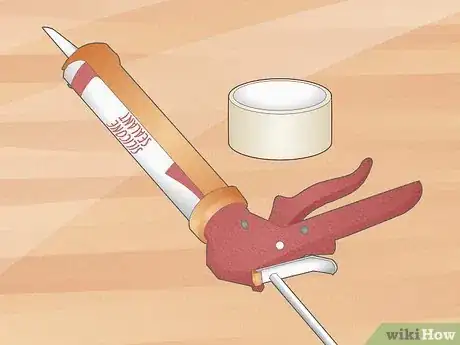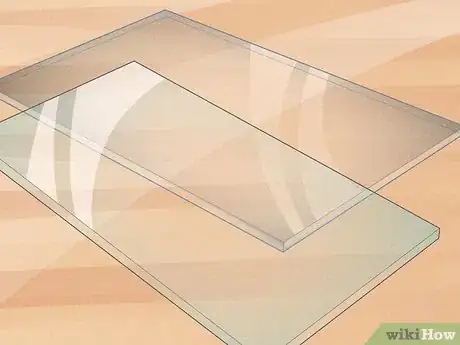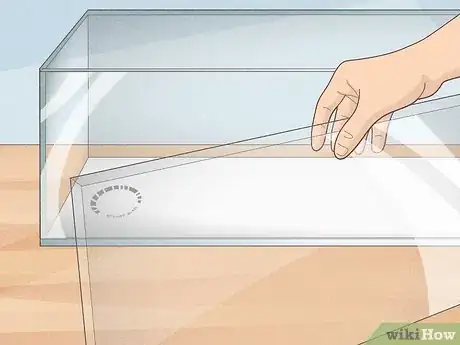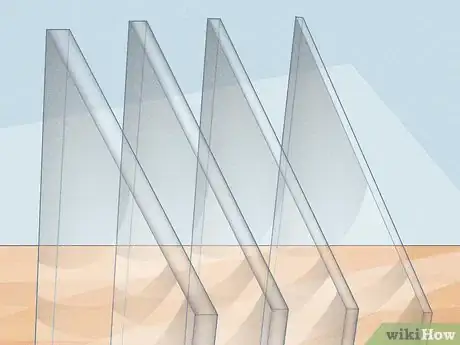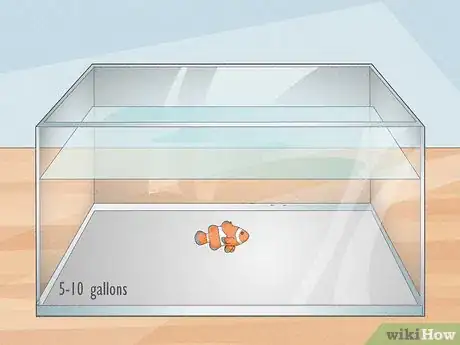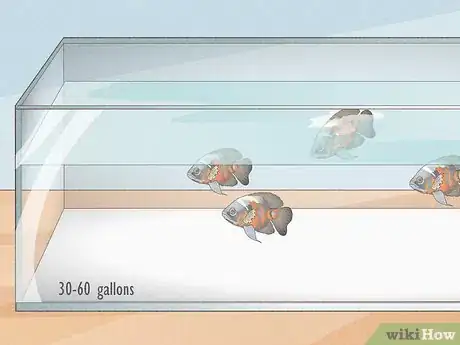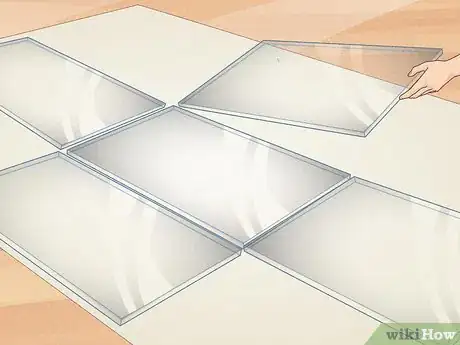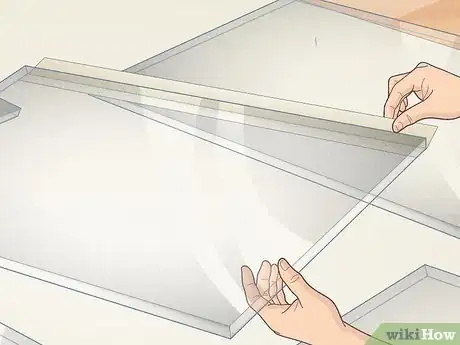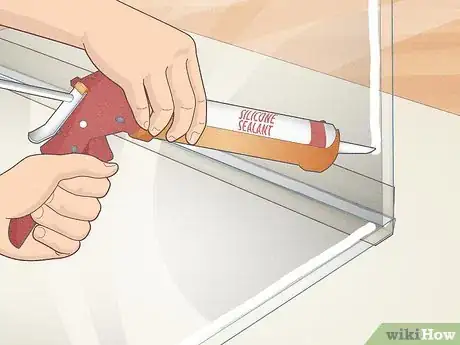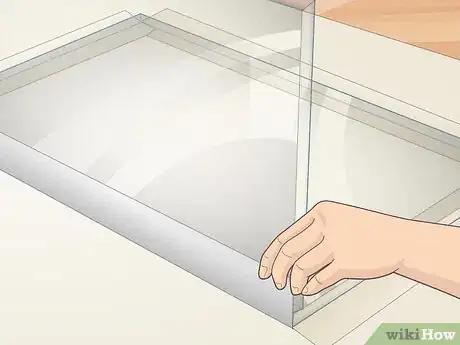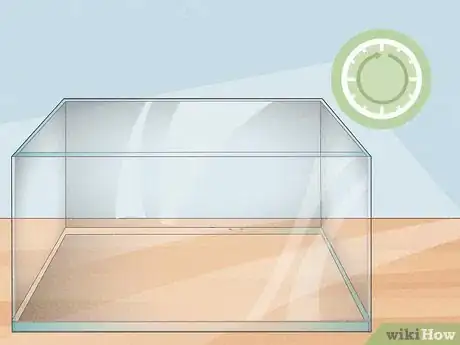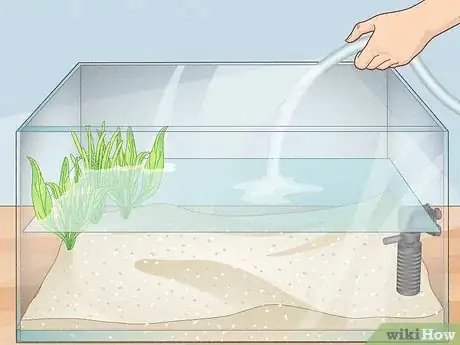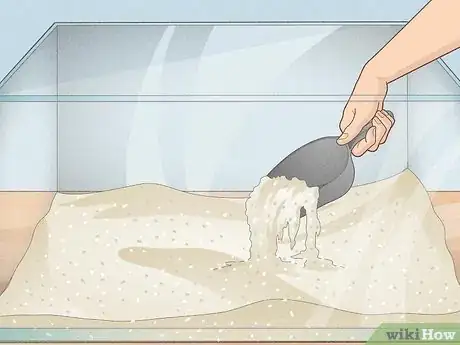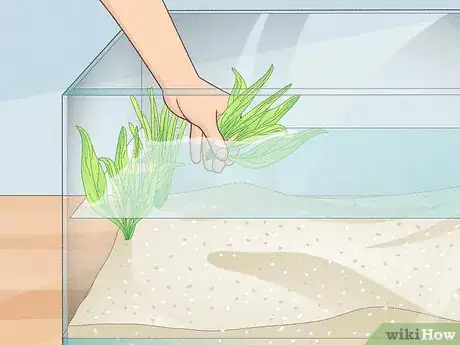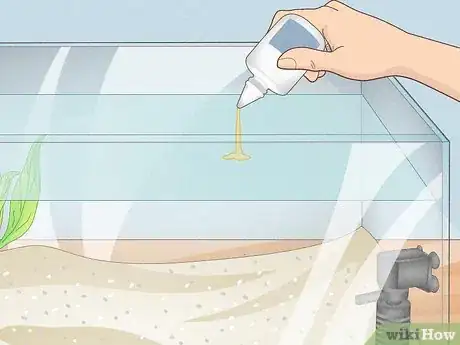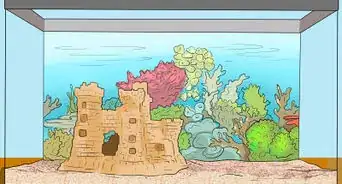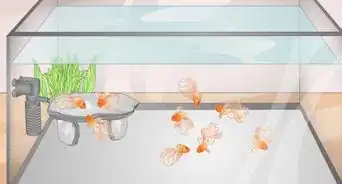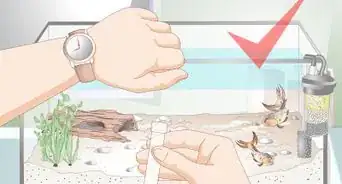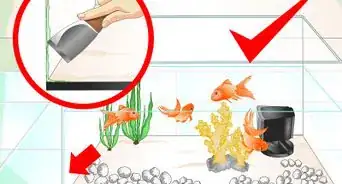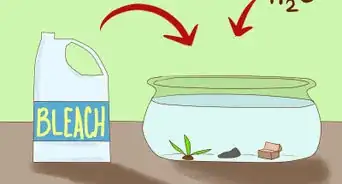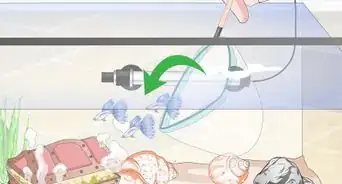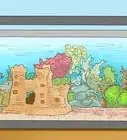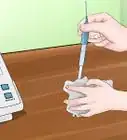This article was co-authored by Aaron Bernard and by wikiHow staff writer, Hannah Madden. Aaron Bernard is an Aquarium Specialist and the Owner of Limited Edition Corals in Phoenix, Arizona. With over ten years of experience, Aaron specializes in aquarium maintenance, custom design, manufacture, installation, and moving. Aaron holds a BS in Biochemistry from Arizona State University, where he studied the effects of climate change on coral reefs and began to propagate his corals.
There are 10 references cited in this article, which can be found at the bottom of the page.
wikiHow marks an article as reader-approved once it receives enough positive feedback. In this case, 87% of readers who voted found the article helpful, earning it our reader-approved status.
This article has been viewed 605,736 times.
If you’ve been dreaming of an aquarium in your own home, you may have considered making one yourself. Not only can it save you money, it’s also a fun DIY activity that you can do by yourself or with a friend. We’ve answered some common questions about making an aquarium so you can get started on this project today.
Steps
What type of glass should you use for an aquarium?
-
1Use acrylic or plexiglass for smaller tanks. If you’re going for a tank smaller than 25 gallons, plexiglass is your best option. It’s flexible, fairly cheap, and you can find it at most hardware stores. However, keep in mind that plexiglass is prone to staining, so it might not be the best choice if you plan to use a lot of chemicals in your water.[2]
-
2Use stained glass or non-tempered glass for larger tanks. Anything above 25 gallons needs something a bit stronger. Stained glass and non-tempered glass isn’t as flexible as plexiglass or acrylic, but it’s thick and it doesn’t scratch easily. It also holds up well over time, so you probably won’t have to replace it in the near future. You can find both kinds of glass at most hardware stores.[3]
How big should an aquarium be?
-
15 to 10 gallons for smaller fish. Guppies, neon tetra, green chromis, and common clownfish only need aquariums that can hold 5 to 10 gallons. If you’d like a school of these fish, 20 to 40 gallons is a better tank size.[5]
-
230 to 60 gallons for larger fish. Oscar fish and royal grammas require a lot more space. If you want a school of large fish, make an aquarium that’s at least 100 to 150 gallons. If you aren’t sure which size you should make, ask the fish expert at your local pet store.[6]
- If you're placing water into the tank, remember that water is very heavy—about 10 pounds per gallon. You may want to go on the smaller side just to keep it more portable.[7]
How do you prep your glass pieces?
-
1Arrange your glass pieces in an open area. Lay down a few pieces of cardboard to protect the glass as you build. Put the bottom piece of the glass down, surrounded by the front, back, and sides.[8]
-
2Rub the sides down with acetone, then apply duct tape. You want all the edges to be clean as can be. Then, cut strips of masking or duct tape that are about half the length of one side. Stick half of each strip on the bottom of the base pane in every direction. The other half of the strip should be lying freely on the table.[9]
How do you assemble your aquarium?
-
1Apply silicone to the edge of the bottom piece. Use a caulk gun to apply a thin, continuous stripe of silicone along the top of the edge. Try to keep the silicone about 2 millimetres (0.079 in) away from the edge as you go. Be sure to work quickly, as silicone sets in 2 to 3 minutes.[10]
-
2Put the front pane in place. With the strip of silicone along the front edge of the base, place the front piece of glass into place, pressing it down firmly but gently. Hold it there briefly, adhere the rest of the tape up the sides, and it should stay up. If you're worried about it falling over, you can prop it up with a large container filled with water or some other heavy object.[11]
-
3Assemble the sides and the back panel in the same way. Run another thin line of silicone 2 millimetres (0.079 in) from the edge along the sides. Then, repeat that along the inside edge of the front pane. Press the first side piece into place, then the other side. Finally, add a line of silicone along the edge of the bottom pane and press it firmly into place.[12]
What should you add to a fish aquarium?
-
1Set up a filter system for freshwater fish. The most common choices are undergravel filters or power filters. A power filter should circulate 5 gallons (18.9 L) of water per hour [gph] and per gallon of your tank's capacity. An 8 gallon (30.3 L) tank would need a power filter that can handle 40 gph.[14]
-
2Fill the bottom with gravel or sand. Most fish will be good with either gravel or sand, and any pet store will offer you a plethora of choices when it comes to texture and color. Whatever you use, 2–3 inches (5.1–7.6 cm) should be plenty. If you choose gravel, give it a quick rinse before you put it into your aquarium to avoid dust in your water.[15]
-
3Add in a few inches of water (if applicable) and your decorations. Everything will be easier to place (and it will stay in place) if you work with a few inches of water in your aquarium. You can place plastic decorations, live plants, or rocks to decorate the area.[16]
- Once you have the terrain all set up, fill the aquarium all of the way up with water. Leave a gap of about 1 in (2.5 cm) from the water to the top of the aquarium.
Expert Q&A
Did you know you can get expert answers for this article?
Unlock expert answers by supporting wikiHow
-
QuestionWhere should I put an aquarium?
 Aaron BernardAaron Bernard is an Aquarium Specialist and the Owner of Limited Edition Corals in Phoenix, Arizona. With over ten years of experience, Aaron specializes in aquarium maintenance, custom design, manufacture, installation, and moving. Aaron holds a BS in Biochemistry from Arizona State University, where he studied the effects of climate change on coral reefs and began to propagate his corals.
Aaron BernardAaron Bernard is an Aquarium Specialist and the Owner of Limited Edition Corals in Phoenix, Arizona. With over ten years of experience, Aaron specializes in aquarium maintenance, custom design, manufacture, installation, and moving. Aaron holds a BS in Biochemistry from Arizona State University, where he studied the effects of climate change on coral reefs and began to propagate his corals.
Fish & Aquarium Specialist
-
QuestionCan you build your own aquarium?
 Aaron BernardAaron Bernard is an Aquarium Specialist and the Owner of Limited Edition Corals in Phoenix, Arizona. With over ten years of experience, Aaron specializes in aquarium maintenance, custom design, manufacture, installation, and moving. Aaron holds a BS in Biochemistry from Arizona State University, where he studied the effects of climate change on coral reefs and began to propagate his corals.
Aaron BernardAaron Bernard is an Aquarium Specialist and the Owner of Limited Edition Corals in Phoenix, Arizona. With over ten years of experience, Aaron specializes in aquarium maintenance, custom design, manufacture, installation, and moving. Aaron holds a BS in Biochemistry from Arizona State University, where he studied the effects of climate change on coral reefs and began to propagate his corals.
Fish & Aquarium Specialist You can, although it's going to be a lot easier to just buy one. Still, it's certainly possible. Just keep in mind that you really need to make sure it's sturdy. Water weighs roughly 10 pounds a gallon and if your DIY aquarium can't handle the weight, you're going to have a major headache on your hands.
You can, although it's going to be a lot easier to just buy one. Still, it's certainly possible. Just keep in mind that you really need to make sure it's sturdy. Water weighs roughly 10 pounds a gallon and if your DIY aquarium can't handle the weight, you're going to have a major headache on your hands. -
QuestionHow tall should I make an aquarium stand?
 Aaron BernardAaron Bernard is an Aquarium Specialist and the Owner of Limited Edition Corals in Phoenix, Arizona. With over ten years of experience, Aaron specializes in aquarium maintenance, custom design, manufacture, installation, and moving. Aaron holds a BS in Biochemistry from Arizona State University, where he studied the effects of climate change on coral reefs and began to propagate his corals.
Aaron BernardAaron Bernard is an Aquarium Specialist and the Owner of Limited Edition Corals in Phoenix, Arizona. With over ten years of experience, Aaron specializes in aquarium maintenance, custom design, manufacture, installation, and moving. Aaron holds a BS in Biochemistry from Arizona State University, where he studied the effects of climate change on coral reefs and began to propagate his corals.
Fish & Aquarium Specialist
Things You'll Need
- 5 sheets of glass
- Aquarium-safe Silicone
- Cloth Gloves for handling glass
- Caulk gun
- Masking or duct tape
- Large containers for support
References
- ↑ https://www.cichlid-forum.com/articles/diy_acrylic_aquarium_3.php
- ↑ https://www.fishkeepingworld.com/how-to-build-a-fish-tank/
- ↑ https://www.fishkeepingworld.com/how-to-build-a-fish-tank/
- ↑ http://www.cichlid-forum.com/articles/diy_acrylic_aquarium.php
- ↑ https://www.fishkeepingworld.com/what-size-fish-tank-should-i-get/
- ↑ https://www.fishkeepingworld.com/what-size-fish-tank-should-i-get/
- ↑ Aaron Bernard. Fish & Aquarium Specialist. Expert Interview. 17 July 2020.
- ↑ https://www.professionalplastics.com/professionalplastics/BuildingAnAquarium2.pdf
- ↑ https://www.professionalplastics.com/professionalplastics/BuildingAnAquarium2.pdf
- ↑ https://www.fishkeepingworld.com/how-to-build-a-fish-tank/
- ↑ https://www.fishkeepingworld.com/how-to-build-a-fish-tank/
- ↑ https://www.fishkeepingworld.com/how-to-build-a-fish-tank/
- ↑ http://beautifuldragons.com/Aquarium.html
- ↑ https://inlandaquatics.com/best-aquarium-power-filters-reviews/
- ↑ https://aquaticdelights.com/blogs/news/which-aquarium-substrates-should-i-use
- ↑ http://www.fishlore.com/fishforum/aquarium-water/121100-how-much-water-how-far-top-rim-filter-output.html
- ↑ Aaron Bernard. Fish & Aquarium Specialist. Expert Interview. 17 July 2020.
About This Article
To make an aquarium, start by choosing 5 pieces of annealed glass to form the sides. Be sure to choose the dimensions that best suit what you plan to hold inside your aquarium. Use a caulk gun to apply silicone, then fit the 5 panes together. Set up the filter system next, then add the heater if your water needs to be warm. Add gravel or sand for the bottom of the tank and fill it with water. After that, plug everything in and add your fish! For more ideas about setting up and decorating the inside of your aquarium, read on!
